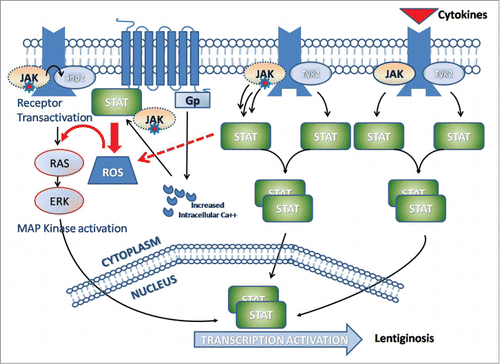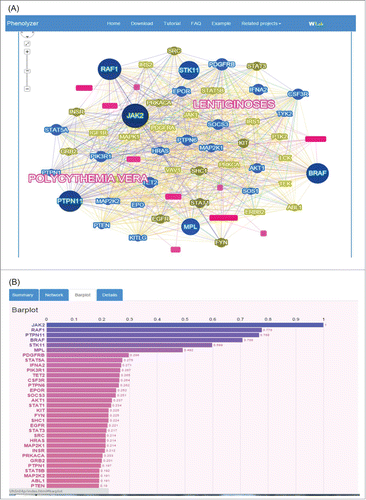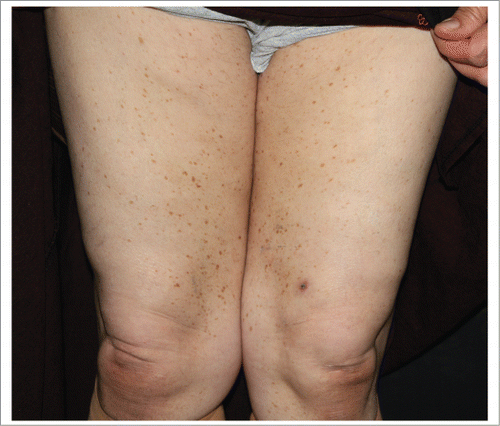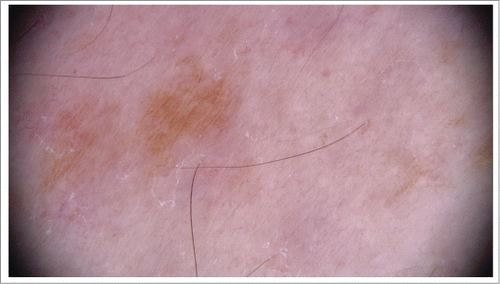Abstract
Lentiginoses is a clinical feature in which lentigines are remarkably present in large numbers or when they occur in a distinctive distribution on apparently normal skin. This entity may be congenital or acquired and may cover a wide spectrum of diseases ranging from an isolated benign pigmentary disorder to numerous syndromes associated with molecular abnormalities.We present a 59-year-old female patient with multiple lentigines which first emerged 3 y ago concurrently with policytemia vera. The patient had found to be positive for Janus Kinase-2 (JAK-2) mutation. Over activation of the pathway due to JAK-2 V617F mutation is a well-known condition in myeloproliferative diseases but has not been reported in melanocytic disorders. Moreover, several signaling pathways have previously been defined with lentiginosis except JAK-STAT pathway. We want to draw attention to the potential effect of JAK-2 mutation in lentigogenesis with this case report.
Introduction
Lentiginoses is characterized by large numbers of lentigines in a distinctive distribution and develop in a period of few months to years.Citation1 This entity may be a part of a well-known syndromes such as Multiple Lentigines Syndrome (formally called LEOPARD syndrome), Noonan syndrome (NS), Carney complex (Lamb syndrome), Peutz-Jeghers Syndrome, Hereditary Gingival fibromatosis type 1 (HGFS), Capillary malformation-AV malformation syndrome (CM-AVS), Neurofibromatosis type 1 (NF-1), Legius syndrome (LS), Costello syndrome (CS), Cardio-facio-cutaneous syndrome (CFC), Autoimmune lymphoproliferative syndrome (ALMS) or might barely seen in healthy people without any systemic disease.Citation2-6 Additionally, chemotherapeutics, topical calcineurin inhibitors and biologic agents may also be associated with multiple lentiginosis.Citation7-9 However, few case reports have been reported regarding to malignancy associated multiple lentiginosis in the literature and currently this entity has been discussed whether it might be a paraneoplastic finding.Citation10,11
The Janus kinases (JAK) and other components of the JAK/STAT pathway are involved in cellular proliferation and differentiation.Citation12 Overactivity of this pathway, in particular to JAK2 mutations, has been shown in etiopathogenesis of many different diseases including inflammatory conditions, hematologic malignancies, and solid tumors.Citation12 Although, the effect of JAK-2 mutation in melanocyte activity and proliferation has not been investigated before, in our case we suppose that mutations of JAK/STAT pathway in relation to Tyrosine kinase activity may be related to melanocytic changes, in the view of the fact that melanocytic changes known to be related to increased tyrosine kinase activity.
Incidental finding of lentigines on a 59 y old female patients diagnosed with Polycythemia Vera was of our interest though it has not been reported before most likely due to miss out of findings in elderly patients. While reviewing the recent studies on tyrosine kinase biology with an attempt to define the possible physiopathology behind this uncovered topic, we came across an interesting relationship of JAK2 mutation and Ras signaling over tyrosine kinase activity.
Case
A 59-year-old female patient admitted to our outpatient clinic with freckling on her lower extremities (). They were first appeared 3 y ago. At that time, she was diagnosed as polycytemia vera with positive JAK2 (V617F) mutation when she had been examined for hypertension and phlebotomy was carried out. She was not exposed to UV, radiotherapy or chemotherapy. There were no similar lesions on her face, trunk or upper extremities and her physical and laboratory findings were totally normal on admission. Dermoscopic examination revealed homogenous reticular structures (). Histopathological examination was consistent with lentiginous proliferation in dermoepidermal junction. Local Kligman's Formula that includes hydroquinone (4%), tretinoin (0.025%), mometasone furoate (0.1%) cream, once daily, was started for her lesions and marked regression was detected on third month control visit. The patient was consulted to Medical Genetics department for further investigations of Lentiginoses. A BRAF mutation analysis tested in skin biopsy DNA was normal. However, according to genetics department inquire, a second superficial excisional biopsy was drawn from the patient's lentigine for JAK2 V617F mutation analysis and the result was positive on real-time polymerize chain reaction ().
Discussion
The etiology of lentiginosis has not fully been understood along with its clinical variability.Citation2,10,11,13 The age of onset and the distribution of the lesions and accompanying symptoms may vary according to the underlying pathology. The earliest onset could be seen in partial unilateral lentiginosis or familial lentiginosis syndromes, however it varies in therapy induced or malignancy associated cases.Citation4,10,11 In the present case, the lentigines had emerged on the lower extremities at the age of 56 together with the diagnosis of one of myeloproliferative disorder.
Malignancy associated lentiginosis was reported in few cases and presented in acral distribution in association with large cell lymphoma of the bowel, breast cancer, adenocarcinoma of the stomach, melanoma and non-Hodgkin lymphoma.Citation11 Additionally, Guttierez-Gonzalez et al. and Wang et al. reported cases of bilateral segmental lentiginosis associated with hepatocellular carcinoma and malignant melanoma, respectively.Citation10,11 In our case, lentigines were similarly distributed on bilateral lower extremities and however accompanied with PV.
Activation of tyrosine kinase is the main underlying mechanism of the syndromes representing multiple lentiginosis.Citation6 Tyrosine kinase is stimulated by receptor (RTKs) or non-receptor tyrosine kinases. RTK signaling transactivate Ras/Erk MAP, PI3K and mTOR pathways that are responsible for regulation of cell growth, proliferation, metabolism and survival.Citation2 Thus, the Ras pathway could be responsible for development of lentiginosis by transactivation of RTK. The syndromes in which Ras pathway is activated the-so-called Rasopathies consist of NS, Multiple Lentigines syndrome, HGFS, CM-AVS, NF-1, LS, CS, CFC and ALMS.Citation5,6 Cutaneous abnormalities including lentiginosis are frequently observed in Rasopathies in addition to predisposition to neural, endocrine and mesenchimal tumors and myeloproliferative diseases.Citation2,3
Polycythemia Vera, presented in our patient, is a myeloproliferative disorder of bone marrow that red blood cells are produced in large amounts. PV is seen in older ages particularly under the effect of acquired somatic mutation of JAK2 (V617F)Citation14,15 that the latter is a diagnostic parameter of the disease.Citation16 JAK2 is a member of the Janus kinase family of non-receptor protein tyrosine kinases and has an important role in the cellular development and homeostasis.Citation17 Though, overactivity of the JAK2, chiefly under the effect of JAK2 (V617F) mutation, is well-known in myeloproliferative neoplasms,Citation16,18,19 its effect in melanocytic disorders has not been elucidated yet.
Different signaling pathways have been defined in pathogenesis of lentiginosis syndromes such as the protein kinase A pathway in Carney complex, the Ras/Erk MAP kinase pathway in LEOPARD/Noonan Syndromes and the mammalian target of rapamycin pathway in Peutz Jeghers Syndrome.Citation2 Furthermore, lentiginosis accompanies to the K-RAS and BRAF related malignancies. In our case, JAK2 gene mutation drawn from the blood was positive but BRAF gene mutation tested in skin biopsy was negative. Unlike the latter, the former has not been connected to Rasopathies previously. Moreover, the patient described in our report did not have features of a defined/recognizable familial lentiginosis syndrome (e.g., Carney complex), and probably did not carry any of the associated germline molecular abnormalities (e.g.,, PTPN11, RAF1, BRAF, SOS1, KRAS, NRAS, PRKAR1A, or PTEN); indeed, the patient's BRAF status was wild-type in skin biopsy DNA. However, though in our patient we did not detect a Rasopathy where the lentiginosis is more common in, JAK2 might have a role in crosstalk of Ras associated intracellular signaling due to positive JAK2V617F mutation in skin biopsy of lentigine which autophosphorylates and mediates the activation of downstream signaling pathways including STATs (STAT5, STAT3, and STAT1), the ERK/mitogen-activated protein kinase (MAPK), and the phosphoinositide 3-kinase (PI3K)/AKT/mammalian target of rapamycin (mTOR). Moreover, aberrant functions of protein kinase have been implicated in the development of melanoma. Though JAK2 is a kind of non-receptor kinase, once it's mutated it gains autonomous activation and lead to continuous or overt downstream signaling (). Therefore, increased total tyrosine kinase activity as a result of JAK2 mutation gave us an impression of whether JAK-2 mutation could have a potential effect on lentigogenesis and even melanoma development.
Figure 3. Hypothetical association of JAK2/ROS/RAS crosstalk pathway leading to lentiginosis (Red Arrows). JAK with red midpoint and blue star represents the mutated JAK2.

In view of the fact that, JAK2 activates non-receptor tyrosine kinase (NRTK) cascadeCitation20 and in our recent study increased ROS (reactive oxygen species; oxidative stress) levels were detected in the PV patients having JAK2 mutation,Citation16 we further hypothesized that JAK2 activates tyrosine kinase by increasing ROS production. Hence, this might be one of the possible pathways of lentiginosis ().
Despite the fact that, there was no study investigating the possible association of lentiginosis and/or melanoma and JAK2 mutation, the melanoma treatment modalities with herbal drugs are based on inhibition of Janus kinase pathway.Citation21-23 Furthermore, the statement of association of increased ROS with melanocytic disordersCitation24 suggested our hypothesis that JAK/ROS/Ras may be an effective pathway in lentiginosis development rather than coincidentality of JAK2 attendance and lentigo formation. For the reason that, when we consider the possible association of the Polycythemia Vera and Lentigine in Phenolyzer (http://phenolyzer.usc.edu/), the most striking gene found to be associated with was JAK2 ().
Figure 4. (A) Phenolyzer image of Lenginosis and Polyceythemia vera association network over JAK2. http://phenolyzer.usc.edu/done/3350/9wmTwOGoCUhSn14p/index.html.) (B) Phenolyzer Barplot of molecule list most related with PV and Lentiginosis association.

Figure 5. Real-Time Polymerase chain reaction (RT PCR) based JAK2 V617F mutation analysis of the patient. Upper graphic represents whether RT PCR has occurred. Lower graphic represents the presence of normal and mutant (V617F) allele of JAK2 mutation at DNA of biopsy drawn from skin lentigines of the patient. (TR PCR was done according to manucfacturer's instructions [JAK2 V617F mutation analyses kit, SNP Biyoteknoloji, Ankara, Turkey], using a Rotor Gene 2Plex [Qiagen, Hilden, Germany] and allelic discrimination analysis was done using Rotor Gene Q Series Software 2.1.0.
![Figure 5. Real-Time Polymerase chain reaction (RT PCR) based JAK2 V617F mutation analysis of the patient. Upper graphic represents whether RT PCR has occurred. Lower graphic represents the presence of normal and mutant (V617F) allele of JAK2 mutation at DNA of biopsy drawn from skin lentigines of the patient. (TR PCR was done according to manucfacturer's instructions [JAK2 V617F mutation analyses kit, SNP Biyoteknoloji, Ankara, Turkey], using a Rotor Gene 2Plex [Qiagen, Hilden, Germany] and allelic discrimination analysis was done using Rotor Gene Q Series Software 2.1.0.](/cms/asset/001947e2-0a46-43be-bdc5-4fec40bd0831/kjks_a_1071000_f0005_oc.gif)
Suggestion of a possible role of JAK2 mutations in lentiginosis syndromes with a single case of a patient with multiple lentigines and concomitant diagnosis of polycythemia vera (PV), might be thought as a ‘fatal flaw’ in the first encounter since JAK2 activating mutations such as V617F in PV are not germline mutations,Citation14 but rather somatic ones - which supposed to occur only in myeloid haematopoietic progenitors/stem cells;Citation25 however in our case, surprisingly the cells comprising the skin lentigines of the reported patient do carry the JAK2V617F mutation (). Therefore, the presence of the mutation may not be restricted to the bone marrow myeloid lineage and other tissues may not be devoid of this mutation. Additionally, one other explanation might also be the over produced circulating soluble mutant JAK2 due to autonomous activity obtained. However, presence of JAK2V617F mutation shown within the lentigines in our patient for the first time, might be an important base to reveal the interaction between JAK2 hyperactivity in the lentigines and genetic features of the lentigines, up to the literature.
Admittedly, there are extremely rare cases of familial PV, but -even in these cases- the detected JAK2 mutation remains somatic in nature and indeed, there has never been a report of germline-mutated JAK2 in pedigrees of familial PV,Citation26 although inheritable single nucleotide polymorphisms (SNPs) of the JAK2 gene (of debatable significance) have been reported.Citation27,28 However, JAK2V617F mutation reported in this particular patient's lentigines might still also be somatic rather than germline in addition to the bone marrow myeloid lineage.
Conclusion
In conclusion, with present case, we for the first time reported JAK2V617F mutation in skin lentigines of a PV patient suggested that JAK2V617F mutation may have a role in lentiginogenesis and lentiginosis might arouse through the JAK/ROS/Ras intracellular signaling crosstalk. Although RAS activation has been proposed as a potential molecular mechanism for resistance of myeloproliferative neoplasm (MPN) clonal cells to JAK inhibition,Citation29 an undisputed basis for establishing all the usual elements of a classic cross-talk between the JAK-STAT and the RAS/ERK/MAPK (or SHP2/PI3K/mTOR/AKT) including ROS pathways has yet to be proven.
Disclosure of Potential Conflicts of Interest
No potential conflicts of interest were disclosed.
References
- Bishop JA. Lentigos, Melanocytic Naevi and Melanoma. In: Burns T, Breathnach S, Cox N, Griffiths N, eds. Rook's textbook of Dermatology. Wiley-Blackwell, 2010:1-5
- Bauer AJ, Stratakis CA. The lentiginoses: cutaneous markers of systemic disease and a window to new aspects of tumourigenesis. J Med Genet 2005; 42:801-10; PMID:15958502; http://dx.doi.org/10.1136/jmg.2003.017806
- Santoro C, Pacileo G, Limongelli G, Scianguetta S, Giugliano T, Piluso G, Ragione FD, Cirillo M, Mirone G, Perrotta S. LEOPARD syndrome: clinical dilemmas in differential diagnosis of RASopathies. BMC Med Genet 2014; 15:44; PMID:24767283; http://dx.doi.org/10.1186/1471-2350-15-44
- Kim MS, Youn SH, Na CH, Kim JK, Shin BS. Generalized eruptive lentiginosis in a healthy elderly man. Ann Dermatol 2014; 26:649-50; PMID:25324666; http://dx.doi.org/10.5021/ad.2014.26.5.649
- Lodish MB, Stratakis CA. The differential diagnosis of familial lentiginosis syndromes. Fam Cancer 2011; 10:481-90; PMID:21538076; http://dx.doi.org/10.1007/s10689-011-9446-x
- Bezniakow N, Gos M, Obersztyn E. The RASopathies as an example of RAS/MAPK pathway disturbances - clinical presentation and molecular pathogenesis of selected syndromes. Dev Period Med 2014; 18:285-96; PMID:25182392
- Uhlenhake EE, Watson AC, Aronson P. Sorafenib induced eruptive melanocytic lesions. Dermatol Online J 2013; 19:18184; PMID:24011281
- Costa LA, Belinchon I, Betlloch I, Perez-Crespo M, Mataix J. Multiple lentigines arising in resolving psoriatic plaques after treatment with etanercept. Dermatol Online J 2008; 14:11; PMID:18319028
- Guttierez-Gonzalez E, Batalla A, de la Mano D. Multiple lentigines in areas of resolving psoriatic plaques after ustekinumab therapy. Dermatol Online J 2014; 20:22338; PMID:24746301
- Gonzalez-Sixto B, Florez A, Conde Taboada A, De la Torre C, Cruces M. Bilateral segmental lentiginosis associated with malignant melanomas. J Eur Acad Dermatol Venereol 2008; 22:1262-3; PMID:18393964; http://dx.doi.org/10.1111/j.1468-3083.2008.02620.x
- Wang YT, Taylor E, Binder S, Mandel H. Bilateral segmental eruptive lentiginosis in a patient with a history of hepatocellular carcinoma. Skinmed 2014; 12:64-5; PMID:24720090
- Quintas-Cardama A, Verstovsek S. Molecular pathways: Jak/STAT pathway: mutations, inhibitors, and resistance. Clin Cancer Res 2013; 19:1933-40; PMID:23406773; http://dx.doi.org/10.1158/1078-0432.CCR-12-0284
- Pretel M, Irarrazaval I, Aguado L, Lera JM, Navedo M, Gimenez de Azcarate A. Partial unilateral lentiginosis treated with alexandrite Q-switched laser: case report and review of the literature. J Cosmet Laser Ther 2013; 15:207-9; PMID:23384078; http://dx.doi.org/10.3109/14764172.2012.758384
- Akalin I, Armangil D, Durmus A. Neonatal Polycythemia May be Free of JAK2V617F Mutation. Turkiye Klinikleri J Med Sci 2013; 33:132-7; http://dx.doi.org/10.5336/medsci.2012-29432
- Posfai E, Marton I, Kiss-Laszlo Z, Kotosz B, Szell M, Borbenyi Z. Thrombosis and risk factors in female patients with a rare acquired thrombophilia: chronic myeloproliferative disorder - polycythaemia vera and essential thrombocythaemia. Eur Rev Med Pharmacol Sci 2014; 18:3810-8; PMID:25555871
- Durmus A, Mentese A, Yilmaz M, Sumer A, Akalin I, Topal C, Alver A. The thrombotic events in polycythemia vera patients may be related to increased oxidative stress. Med Princ Pract 2014; 23:253-8; PMID:24642873; http://dx.doi.org/10.1159/000360102
- Akada H, Akada S, Hutchison RE, Sakamoto K, Wagner KU, Mohi G. Critical role of Jak2 in the maintenance and function of adult hematopoietic stem cells. Stem Cells 2014; 32:1878-89; PMID:24677703; http://dx.doi.org/10.1002/stem.1711
- Tefferi A. Novel mutations and their functional and clinical relevance in myeloproliferative neoplasms: JAK2, MPL, TET2, ASXL1, CBL, IDH and IKZF1. Leukemia 2010; 24:1128-38; PMID:20428194; http://dx.doi.org/10.1038/leu.2010.69
- Durmus A, Mentese A, Yilmaz M, Sumer A, Akalin I, Topal C, Alver A. Increased oxidative stress in patients with essential thrombocythemia. Eur Rev Med Pharmacol Sci 2013; 17:2860-6; PMID:24254553
- Finbloom DS, Larner AC. Regulation of the Jak/STAT signalling pathway. Cell Signal 1995; 7:739-45; PMID:8593242; http://dx.doi.org/10.1016/0898-6568(95)02004-7
- Li MY, Tian Y, Shen L, Buettner R, Li HZ, Liu L, Yuan YC, Xiao Q, Wu J, Jove R. Three-O-methylthespesilactam, a new small-molecule anticancer pan-JAK inhibitor against A2058 human melanoma cells. Biochem Pharmacol 2013; 86:1411-8; PMID:24021352; http://dx.doi.org/10.1016/j.bcp.2013.08.065
- Nam S, Xie J, Perkins A, Ma Y, Yang F, Wu J, Wang Y, Xu RZ, Huang W, Horne DA, et al. Novel synthetic derivatives of the natural product berbamine inhibit Jak2/Stat3 signaling and induce apoptosis of human melanoma cells. Mol Oncol 2012; 6:484-93; PMID:22717603; http://dx.doi.org/10.1016/j.molonc.2012.05.002
- Aftimos PG, Wiedig M, Langouo Fontsa M, Awada A, Ghanem G, Journe F. Sequential use of protein kinase inhibitors potentiates their toxicity to melanoma cells: a rationale to combine targeted drugs based on protein expression inhibition profiles. Int J Oncol 2013; 43:919-26; PMID:23835698
- Liu-Smith F, Poe C, Farmer PJ, Meyskens FL, Jr. Amyloids, melanins and oxidative stress in melanomagenesis. Exp Dermatol 2014; 24(3):171-4; PMID:25271672
- Koopmans SM, Schouten HC, van Marion AM. BCR-ABL negative myeloproliferative neoplasia: a review of involved molecular mechanisms. Histol Histopathol 2015; 30:151-61; PMID:25196073
- Langabeer SE, Haslam K, Linders J, Percy MJ, Conneally E, Hayat A, Hennessy B, Leahy M, Murphy K, Murray M, et al. Molecular heterogeneity of familial myeloproliferative neoplasms revealed by analysis of the commonly acquired JAK2, CALR and MPL mutations. Fam Cancer 2014; 13:659-63; PMID:25103330; http://dx.doi.org/10.1007/s10689-014-9743-2
- Koh SP, Yip SP, Lee KK, Chan CC, Lau SM, Kho CS, Lau CK, Lin SY, Lau YM, Wong LG, et al. Genetic association between germline JAK2 polymorphisms and myeloproliferative neoplasms in Hong Kong Chinese population: a case-control study. BMC Genet 2014; 15:147; PMID:25526816; http://dx.doi.org/10.1186/s12863-014-0147-y
- Oh ST, Gotlib J. JAK2 V617F and beyond: role of genetics and aberrant signaling in the pathogenesis of myeloproliferative neoplasms. Expert Rev Hematol 2010; 3:323-37; PMID:21082983; http://dx.doi.org/10.1586/ehm.10.28
- Winter PS, Sarosiek KA, Lin KH, Meggendorfer M, Schnittger S, Letai A, Wood KC. RAS signaling promotes resistance to JAK inhibitors by suppressing BAD-mediated apoptosis. Sci Signal 2014; 7:ra122; PMID:25538080


